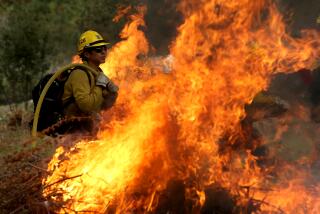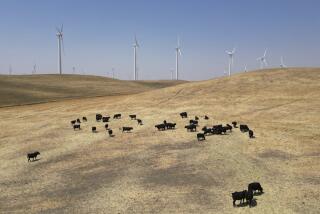New developments mask wild land’s deadly threat
The enduring image of the Southern California hillside resident -- the one who braces for disaster every fall, just as the Santa Anas begin to blow -- is that of a self-reliant, latter-day homesteader who settled up among the trees because he finds solitude and freedom there. And maybe because he remains a bit suspicious of life in the city.
It wasn’t hard to find examples of the breed in news coverage of last week’s devastating fires, guiding horses to safety or crustily refusing to evacuate. Yet the vast majority of the nearly 2,000 houses destroyed so far weren’t outposts marking the last remaining frontiers of the American West. They were neatly lined up in subdivisions, on gently curving streets slotted into terraced hillsides. Many of the biggest fires grew by leaping from one cul-de-sac to the next, tearing through the territory that writer Mike Davis once called “Sloping Suburbia.”
Since the middle of the 20th century, this is how we have developed much of our new housing in the U.S., and particularly in Southern California: by pushing deep into canyons and deserts and onto flood plains. We build reassuringly familiar-looking subdivisions, decorated with vaguely Spanish or Mediterranean accents, in locations that by land-use standards -- and by common-sense standards -- are truly exotic. We build with the unstinting belief that growth is good and that progress in the form of various kinds of technology -- new building materials, military-style firefighting, a vast system of pumps and levees -- will continue to make it possible to construct new pockets of nostalgic architecture virtually anywhere.
But maybe our nostalgia should extend beyond red-tile roofs to include earlier lessons about how and where it is safe to build. This country’s culture as a whole is in the midst of a profound shift from the unshakable confidence that marked the so-called American Century to a new recognition of risk, conservation, even fragility. Green architecture, with its rather old-fashioned emphasis on paying attention to site and climate, is part of that shift. But those who build and approve new hillside developments -- “the lords of subdivision,” as nature writer Richard Lillard called them, the “replanners of the Earth’s surface” -- have barely acknowledged it.
One of the success stories of the last week has been Stevenson Ranch near Santa Clarita, which narrowly averted destruction in part because its houses were built with concrete roof tiles and heat-resistant windows. But to celebrate this neighborhood as a model for escaping fire is itself a kind of escapism. The question is never, why am I building here on this hillside that predictably catches fire every few years in the fall (and maybe now in spring or summer too)? It is, instead, how can technology and new materials -- how can progress -- protect me from the dangers inherent in living where I have chosen to live?
The aesthetic basis of a typical subdivision is reassurance and stability. Builders enforce those qualities with architecture, choosing from a well-worn catalog of residential styles, and with massive earthmoving operations, to flatten the streets and blur the topographical differences between one hillside and the next.
The media pitch in too. Thursday night on CNN, Anderson Cooper and other anchors focused relentlessly on the news that an arsonist may have set the Santiago fire in eastern Orange County. The Santiago fire destroyed 14 houses -- a tiny fraction of the total this week. By contrast, the Witch fire that roared through suburban developments in northern San Diego County, consuming more than 1,000 houses, was caused by downed power lines. The emphasis on possible crime suggested that the disaster could be pinned on a few rogue evildoers. But the vast majority of destroyed houses burned as a direct result of choices made by home builders, homeowners, politicians and planners about where to put new development. The villain is us.
The truth is that while houses near Lake Arrowhead and in certain canyons that burned this year are marked by real isolation, most Southern California residents who move into fire-threatened hillside neighborhoods are not adventurous souls hoping to thumb their noses at convention and urban mores and carve out a life surrounded by nature. They are merely looking for spacious single-family residences that feel attractively adjacent to, rather than in the heart of, the hills and mountain ranges that divide the region’s coastline from its deserts.
Adjacency to nature rather than full immersion in it has always been at the heart of the suburbs’ appeal. The developers who create our version of it, particularly in the fastest-growing parts of Los Angeles, Orange and San Diego counties, have been highly successful at giving their projects the air of the familiar mixed with a touch of unspoiled landscape.
Disasters, though, have a way of stripping away those signs of comfort and rather starkly revealing land-use patterns as well as the philosophies that underpin growth. The flooding in New Orleans that followed Hurricane Katrina, for example, wiped out mostly suburban-style ranch houses that had been built slab-on-grade, without the raised foundations and other low-tech flood-protection mechanisms that once distinguished the city’s houses.
There is a reason that the oldest neighborhoods in New Orleans virtually never flood. They were built on naturally high ground, produced over the centuries by deposits of Mississippi River silt. And there is a reason that wildfires in Southern California prey mostly on subdivisions built in the last 50 years or so, when suburban expansion and faith in American know-how were at their height.
We can draw a final connection here, even if it is only a metaphorical one. The way that American home builders keep pushing out into new territory, developing parcels of land once considered unsafe for residential construction, is an architectural version of the way that banks and lenders have acted over the last decade, practically tossing money at borrowers once dismissed as too much of a credit risk. The goal in both cases is to maintain a pace of growth and expansion that is ultimately unsustainable.
The crisis in the credit markets, by pulling down the broader economy, has shined some needed light on predatory lending and slowed its spread. Though history suggests that we probably shouldn’t hold our breath, perhaps the fires, by the sheer scale of their destruction, will have a similar effect on the way we build.
christopher.hawthorne
@latimes.com
More to Read
Start your day right
Sign up for Essential California for news, features and recommendations from the L.A. Times and beyond in your inbox six days a week.
You may occasionally receive promotional content from the Los Angeles Times.







